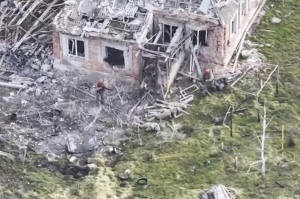Video shows 4 captive Ukrainian troops killed by men identified as
Russian forces
[April 10, 2025]
By ERIKA KINETZ, JOHN LEICESTER and BEATRICE DUPUY
ROME (AP) — The Ukrainian soldiers clambered from the ruined house at
gunpoint — one with arms raised in surrender to the Russian troops — and
lay face-down in the early spring grass.
Two drones — one Ukrainian and one Russian — recorded the scene from
high above the southern Ukrainian village of Piatykhatky. The Associated
Press managed to get both videos. They offer very different versions of
what happened next.
The Ukrainian drone video, which AP obtained from European military
officials, shows soldiers with Russian uniform markings raising their
weapons and shooting each of the four Ukrainians in the back with such
ferocity that one man was left without a head.
“Out of all the executions that we’ve seen since late 2023, it’s one of
the clearest cases,” said Rollo Collins of the Center for Information
Resilience, a London group that specializes in visual investigations and
reviewed the video at AP’s request. “This is not a typical combat
killing. This is an illegal action.”
The Russian drone video, which AP located on pro-Kremlin social media,
cuts off abruptly with the men lying on the ground — alive. “As a result
of the work done by our guys, the enemy decided not to be killed and
came out with their hands up,” wrote a Russian military blogger who
posted the video.
Two videos. Two stories. In one, the prisoners appear to live. In the
other, they die.
As evidence of potential war crimes continues to mount, many in Ukraine
worry that the Trump administration’s about-face on the war will make it
more difficult to establish a firm historical narrative about what has
happened since Russia’s 2022 invasion and whether those most responsible
for atrocities will ever be held accountable.

On March 13, the day European officials say the incident in Piatykhatky
took place, U.S. representatives landed in Russia for ceasefire talks
with President Vladimir Putin.
President Donald Trump, who has signaled that a prospective deal could
see Ukraine surrender some territory and echoed Moscow’s talking points,
called for a quick peace deal. His administration has pulled back
support for Ukraine, including war crimes investigations, and is
rebuilding relations with Putin — the very man many victims and
prosecutors want to see in court.
“Whatever a peace agreement would be, Ukraine is not ready to forgive
everything which happened in our territory,” Yurii Bielousov, head of
the war crimes department for Ukraine’s prosecutor general, told AP. “In
which form there will be accountability, that we don’t know at the
moment.”
Kremlin denies a policy of killing POWs
The killing of surrendering POWs in the Ukrainian video — a crime under
international law — was not unique, according to Ukrainian prosecutors,
international human rights officials and open-source analysts.
At least 245 Ukrainian POWs have been killed by Russian forces since the
full-scale invasion, according to Ukrainian prosecutors. They allege
it’s part of a deliberate strategy encouraged by Russian officials.
“It’s definitely part of the policy, which is fully supported by the top
leaders of the Russian Federation,” Bielousov told AP. “This isn’t the
action of specific commanders. It is supported on the top level.”
Asked about Russia's treatment of Ukrainian prisoners of war, Kremlin
spokesman Dmitry Peskov said Russia treats surrendering Ukrainian troops
in accordance with international law and does not encourage the killing
of POWs.
“This is not a policy of the Russian side,” he told AP, and repeated
Moscow's claims that atrocities committed by its troops in the Ukrainian
town of Bucha were faked.
In the occupation of that town outside Kyiv early in the war, hundreds
of Ukrainians were killed. Overwhelming evidence, including witness
testimony, photos, CCTV videos, phone intercepts and corpses of
civilians, substantiated those deaths.
The battle for Piatykhatky
The drone video in Piatykhatky was taken by Ukraine’s 128th Mountain
Brigade, according to military officials with a European country that
Ukrainian authorities shared the video with. The AP obtained it on
condition of anonymity because the officials were not authorized to
release it.

Intense fighting has devastated this crossroads in the Zaporizhzhia
region. Fresh scorch marks stain the grass and what houses remain are
missing roofs and windows. The battle has been part of a scramble to
seize territory ahead of peace talks, with Russia seeking a strategic
foothold to force Ukraine to restructure its logistics lines, according
to military analysts.
Russian soldiers planted their flag amid the ruins of Piatykhatky last
month, according to a drone video posted March 11 by pro-Kremlin
bloggers.
Two days later, the Russian and Ukrainian drones recorded the surrender
of the four Ukrainian soldiers about 100 meters (yards) away.
The Russian video shows an explosive drone flying in the window of the
house where Ukrainians took cover, detonating with a flash.
Both countries' drones recorded one of the Ukrainians, arms raised and
seemingly unarmed, leaving the shattered house. With a Russian soldier
pointing his gun at him, the man plants himself spread-eagled next to
his comrades on the ground.
European military officials who analyzed the video said the Russians are
identifiable by red or white markings on their uniforms.
The Ukrainian video shows the Russians briefly searching their
prisoners. Two more Russians arrive and consult with comrades. One
pauses to use his radio.
[to top of second column]
|

This image taken from video that European military officials say was
filmed by a Ukrainian drone in the southern Ukrainian village of
Piatykhatky on March 13, 2025, shows three soldiers with red helmets
and uniform markings identified as Russian surrounding four
Ukrainian soldiers who appear to have surrendered and are laying on
the ground. (Ukraine Military/European Defense Officials via AP)

What happens next was cut from the Russian video. One Russian walks
to the prisoners, raises his gun with one hand and starts firing.
Another soldier shoots, too. While he reloads, a third Russian joins
in, firing at least two shots at close range that take off the
helmet — and head — of one man. Then the soldier who’d been
reloading finishes off the four Ukrainians, methodically shooting
each, one by one.
Neither video shows how the first Ukrainian soldier got out of the
house.
Ukraine’s 128th Mountain Brigade declined comment because the deaths
are being investigated as a suspected war crime. Ukraine’s internal
security agency confirmed to AP it has opened an investigation.
Russian military bloggers who posted the edited video said it shows
the work of an assault unit from Russia’s 247th Airborne Regiment.
Russia’s Ministry of Defense did not respond to requests for comment
on the incident.
Analysts at the Center for Information Resilience confirmed the
videos were recorded by different drones, as well the location and
identifying marks of the soldiers.
“For us, this is very much a quite clinical, methodical process of
execution,” said Collins, the CIR analyst. “It follows on from a
very consistent sort of trend that we’ve seen since at least
December 2023.”
A surge in killings of POWs
Russia also claims to have documented “systematic killings” of
Russian POWs by Ukrainian troops but didn’t give overall numbers. In
March, the Russian Foreign Ministry released testimony from Russian
POWs exchanged by Ukraine who described beatings and torture in
custody. Some reported “a practice of finishing off wounded Russian
fighters, as well as executing combatants who have laid down their
arms.”
The Investigative Committee, Russia’s top state criminal
investigation agency, said in December it had opened over 5,700
criminal cases into alleged Ukrainian crimes since the start of the
conflict.
The U.N. Human Rights Monitoring Mission in Ukraine has documented
91 extrajudicial killings of Ukrainian POWs since August 2024.
During the same period, it found a single case of Ukrainian soldiers
killing a Russian POW.

Bielousov, the Ukrainian war crimes prosecutor, said all such
allegations against Ukrainian troops are being investigated.
Danielle Bell, head of the U.N. Human Rights Monitoring Mission in
Ukraine, said the increase in POW killings by Russian forces hasn't
happened in a vacuum. Russia enacted laws shielding soldiers from
prosecution, she said, and officials have called for the killing or
torture of Ukrainian POWs and endorsed reported extrajudicial
killings. Multiple videos of POW killings have appeared online, some
posted by Russian soldiers themselves, she noted, suggesting an
environment of broad impunity.
“Calls on social media by public officials, amnesty laws,
dehumanizing language within the context of impunity for these acts
— it’s contributing to an environment that allows such acts or these
crimes to take place,” she said.
Tracking war crimes
Extrajudicial killings are among over 157,000 potential war crimes
Ukrainian prosecutors are investigating. Ukraine has relied on
international support to help process that flood of information and
structure complex cases for both international and domestic courts.
That work is suffering since the Trump administration’s cuts to
foreign aid.
Among those hit was the Ukrainian Helsinki Human Rights Union, which
lost $5 million from cuts to the U.S. Agency for International
Development. It had been using the money to collect evidence of
offenses ranging from property damage to sexual assaults. The
nongovernmental organization has cut staff, reduced operations and
moved out of its Kyiv offices, executive director Oleksandr
Pavlichenko told AP.
U.S. funding to groups investigating atrocities in Cambodia and
Syria helped build war crimes cases years later. It took over two
decades to bring top leaders of the Khmer Rouge before a U.N.-backed
court on war crimes charges stemming from their brutal rule in the
1970s that led to 1.7 million deaths. Prosecutors relied on archives
of the Documentation Center of Cambodia, established with U.S.
government funding.
If not for that center, “there would have been no Khmer Rouge
Tribunal. Period,” said Christopher “Kip” Hale, a criminal law
expert who worked at the tribunal and has worked in Ukraine.
“To have durable peace, we have to have accountability. We have to
invest now,” he said. "Without it, we see that ceasefires and
armistices are just waiting periods for the next conflict to start.”
___
Leicester reported from Paris and Dupuy reported from New York.
Volodymyr Yurchuk in Kyiv, Ukraine; Molly Quell in The Hague,
Netherlands; Yuras Karmanau in Tallinn, Estonia; and Emma Burrows in
London contributed.
All contents © copyright 2025 Associated Press. All rights reserved |